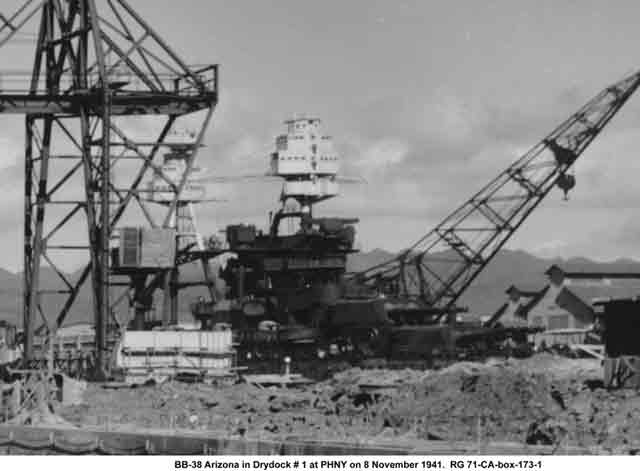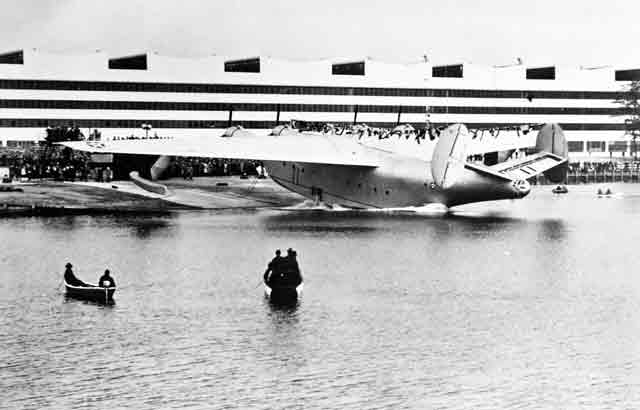Tuesday 13 January 1942
 |
| Heinkel He 280 V-1 DL+AS with engine intake fairings. The jet engines are not available on 13 January 1942, so the Germans are only conducting glider tests. |
Battle of the Atlantic: Operation Drumbeat (Unternehmen Paukenschlag) officially begins on
13 January 1942. The first of vie German U-boats begin arriving along the east coast of the United States during the day, though most are still making the transatlantic crossing. While U-123 (Kptlt Reinhardt Hardegen) already has sunk British freighter Cyclops on 11 January, that was on the outbound journey about 300 miles east of Cape Cod and was not officially part of Operation Drumbeat. Following that success, Hardegan continued west and today arrives along the coast. Not sure where he is, Hardegan proceeds southwest toward Rhode Island Sound. Hardegan then spots the Montauk Point lighthouse on the eastern tip of Long Island and quickly establishes his position. The U-boat commanders and crews are astonished to find U.S. shipping to be operating in peacetime conditions. Not only are the ships illuminated, but the cities and towns along the shore have not imposed blackouts, which makes spotting even darkened ships easy. There also are few if any naval patrols and no convoys. Air patrols are spotty, with some conducted by blimps. This is a huge change from conditions everywhere else in the world.
 |
| Plattsburgh Daily Republican, January 13, 1942 (Plattsburgh, N.Y.). |
Battle of the Pacific: With the Japanese having closed up on the Allied outpost line across the neck of the Bataan Peninsula, General MacArthur decides to launch some spoiling attacks. On the east flank of II Corps (eastern half of the line), the Filipino 21st Infantry Division launches an attack at 06:00. Preceded by an artillery barrage, this attack clears a small area on the left flank of the Philippine Scouts 57th Infantry Division. As hoped, this sets back Japanese plans to launch their own attack there. Further west, however, the Filipino 51st Division is forced to withdraw from the outpost line to the definitive line along the Balantay River. These are all preliminary moves, with the Japanese not yet in a position to launch a set-piece attack to break the Allied defenses.
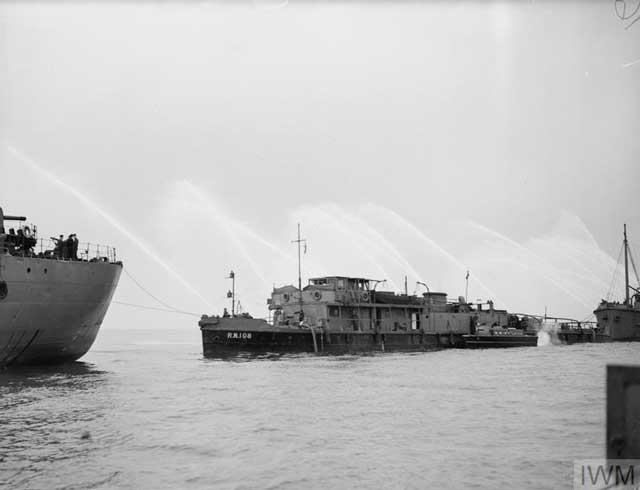 |
| "A long line of fire pumps pouring out thousands of gallons of water a minute from fire fighting ships during the demonstration." Gourock, on the Clyde, 13 January 1942. © IWM (A 7248). |
On the Malay Peninsula, General Archibald Lord Wavell, Commander in Chief Australian-British-Dutch- American (ABDA) Command, South West Pacific, visits the front. The Indian III Corps is withdrawing into Johore State, with vehicles routed through Segamat. Johore is the final tranche of land on the mainland north of Singapore. Wavell already has instructed local commander General Arthur Percival to build fortifications on Singapore Island to repel an invasion, but he has not done so. The Australian 8th Division, commanded by Major-General Gordon Bennett, replaces the 11th Indian Division on the front lines, as the 11th Division has been devastated in the battles further north.
A convoy arrives in Singapore bringing 51 Hurricane fighters but only 24 pilots. There are surplus pilots in Singapore, but they are Brewster Buffalo pilots and will have to retrain in the new planes. The planes also will take time to assemble and get ready for flight.
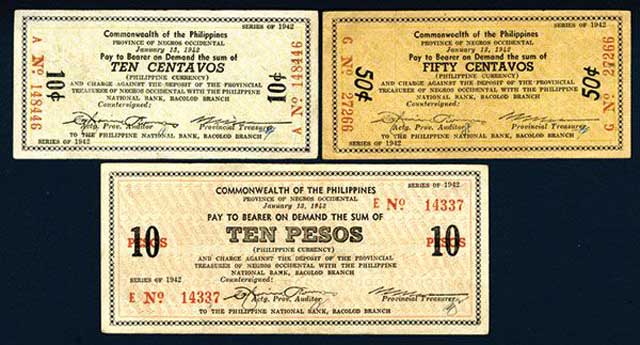 |
| Coupon checks issued by the Philippines government dated 13 January 1942. Despite the battle underway in Bataan, the business of government continues. |
On Tarakan Island, the Dutch are retreating toward Kembes. However, their native soldiers are deserting, and Captain W.F.J. Kroon of Compagnie Menado is forced to surrender. The Japanese soon execute all of the Europeans (about 8) except for Kroon himself. The next Japanese objective in the region is Balikpapan.
In Burma, the Joint Military Council notes the rapid advance of the Japanese into the country. The generals propose building a new supply road to the Nationalist Chinese through northern Burma which they have a better chance of holding against the Japanese invasion. This road, north of the current Burma Road, will run through Myitkyina and connect to the current Burma Road at Wandingzhen, Yunnan. This eventually is called the "Ledo Road." Its construction is a massive project through very rough terrain and depends on holding northern Burma, which is by no means certain. The Japanese are invading Burma, in fact, in large part to cut off such roads which enable Chiang Kai-shek to hold out in Chungking. The only alternative to a road from India to China is air supply, which requires a dangerous flight over the Himalayas (known as "the Hump"). However, the Allies at this time do not have aircraft for sustained use of this route.
 |
| The cover story in the 13 January 1942 Look magazine is "Our War With Japan." |
Eastern Front: Generalmajor Maximilian Fretter-Pico now has four Axis Divisions in position for an attack on the new front in the Crimea at the Parpach Narrows. The objective will be the recapture of the port of Feodosia on the south coast and destruction of the Soviet 44th Army. The Luftwaffe has brought powerful units east from refittings in the Reich and the local command is led by General Robert Ritter von Greim. General Erich von Manstein's 11th Army still maintains a siege around Sevastopol in the west, but offensive operations there are unlikely while the Soviets maintain a presence centered on Kerch.
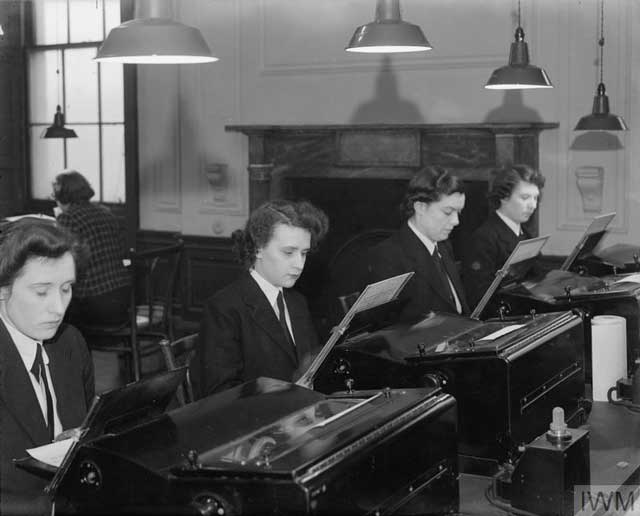 |
| "Teleprinters in training concentrating on the job." Leonard House, Rosyth Command, 13 January 1942. © IWM (A 7041). |
The situation west of Moscow continues to deteriorate for the Wehrmacht. During the morning, Soviet I Guards Cavalry Corps crosses the
Rollbahn, the main road between Vyazma and Rzhev. Fourth Army is forced to evacuate Medyn, a key position just to the south. The critical railway that supplies several German armies lies just to the west, and the Germans manage to get one last train of supplies through before the Red Army cuts the line to Rzhev. At Sychevka just to the north, the Ninth Army headquarters comes under Soviet attack. General Strauss, the army's commander, stays in Sychevka but orders his staff south to Vyazma. At around dusk, he leaves also. The Germans have a plan to close the gap, but the loss of Medyn - one of the "corner posts" for the operation - renders that virtually unachievable. One thing is clear, however, and that is that the Germans have to reopen the railway line north to Rzhev or the position there is unsustainable. The prospect of losing entire armies is now becoming close to reality for the Germans.
 |
| Damage caused by "the Waller's raid" on 13 January 1942 in Lowestoft. This view is from London Road north facing east. |
Western Front: Just before dusk, a lone Dornier bomber bombs Lowestoft, England, during a heavy snowfall. Four bombs land in the main shopping area at tea time and kill 70 people, including 50 sailors. Many of the casualties are in Waller's restaurant, hence this is often called "the Waller's raid." The town's largest cinema, the Odeon, is hit, and a complete block of shops is destroyed. The dead include the wife of the Superintendent of Police, Mrs. Mills. Waller's orders thirty wreaths for the graves.
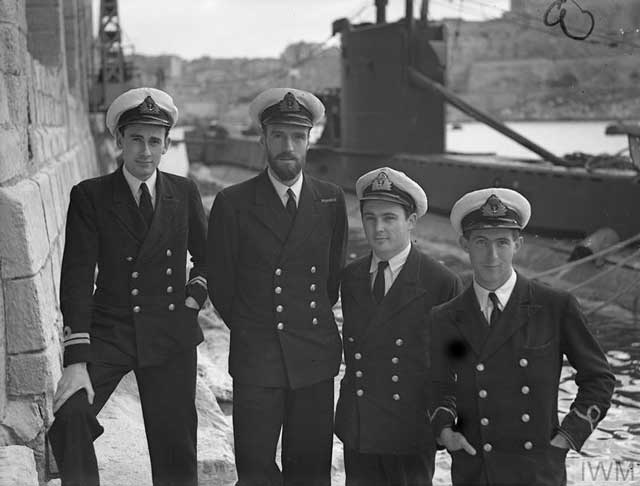 |
| 'Officers of UPHOLDER. Left to right: Lieut F Ruck-Keene; Lieut Cdr Wanklyn, VC, DSO, RN; Lieut J R Drummond, RN; Sub Lieut J H Norman, RNVR." They are assembled at a submarine base in Lazzaretto, Mandel Island, Malta, on 13 January 1942 for Wanklyn to receive the Victoria Cross (© IWM (A 7295)). |
Allied Relations: In London, Representatives of nine German-occupied nations sign a declaration, approved by the United States, Britain, and the Soviet Union, that vows punishment against those who order war crimes and those who participate in them. The document provides for:
the punishment, through the channels of organized justice, of those guilty of, or responsible for, these crimes, whether they have ordered them, perpetrated them, or participated in them.
Polish General Wladyslaw Sikorski and French General Charles de Gaulle are among the signatories.
At the Arcadia Conference in Washington, which is in its final days, the Combined Chiefs of Staff agree to begin moving some United States Air Force units to the United Kingdom as soon as possible. The US Army V Corps already has a presence there.
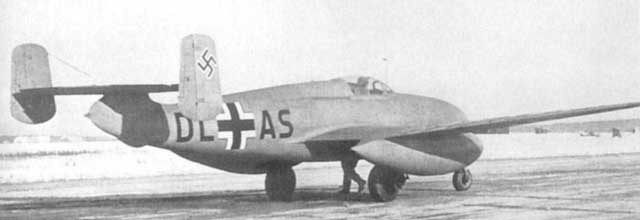 |
| The prototype Heinkel He 280 V1, DL+AS, with engine intakes and exhausts faired over, that was lost 13 January 1942 when Helmut Schenk successfully ejected from it. |
German Military: The Luftwaffe secretly has been developing ejection seats, and on 13 January 1942, they get their first successful use in a real-life crisis. While piloting the Heinkel He 280 prototype jet-engined fighter, which is equipped with an ejection seat that has never been used, test pilot Helmut Schenk finds that the plane's control surfaces have iced up and become inoperative. Schenk pulls the lever at 2400 meters (7875 feet) after severing his tow line to a pair of Bf 110C tugs (the plane's jet engines are not ready yet). Ernst Heinkel is developing the He 280 without official Luftwaffe support and it never goes into operation, but this successful use of an ejection seat is a world-first for any plane. The Luftwaffe also is putting ejection seats into other fighters it is developing such as the Heinkel He 219 Uhu (Owl) night fighter. The Allies, however, have no ejection seats in development and no plans to do so.
US Military: Some sources place the first flight of the Igor Sikorsky USAAF R-4 helicopter on 13 January 1942. However, better records suggest that it takes place on 14 January, so we discuss it there.
 |
| The prototype He 280 V1 DL+AS being towed by a Heinkel He 111 bomber on a previous flight. |
British Homefront: A puzzle is printed in the 13 January 1942 edition of The Daily Telegraph. It had been created by W.A.J. Gavin, chairman of the Eccentric Club. It is very difficult because he thought the crossword puzzles in the publication were not hard enough. A small group of ordinary citizens is invited to the newsroom to try to solve the puzzle within a 12-minute deadline (five people manage to do this). Someone from the War Office takes down the names of some of the people and invites them to interview with Colonel Nichols of the General Staff. Several of the puzzle-solvers wind up working at Bletchley Park helping to decipher German military codes from the Enigma machine in the top-secret Ultra program. It turns out that many of the codebreakers, not just the Daily Telegraph people, are crossword fans.
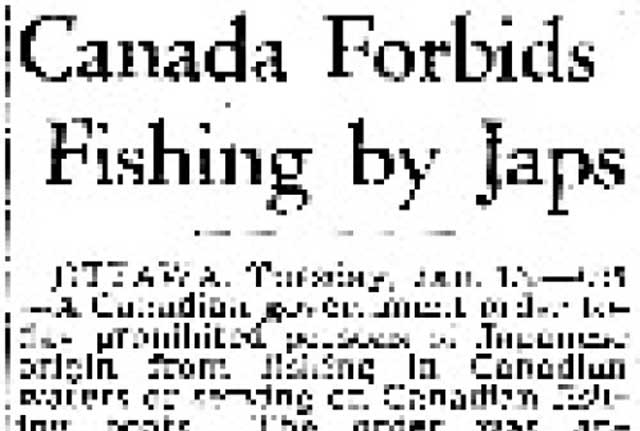 |
| Japanese-Canadians are barred from fishing, 13 January 1942. |
Canada Homefront: War hysteria is reaching a crescendo all along the west coast of the United States and Canada. There are numerous reports of "suspicious activities" being printed in newspapers. Among other things, the Canadian government in Ottawa today prohibits fishing by Japanese-Canadians.
 |
| Henry Ford, right, with his famous "plastic" soybean car. |
American Homefront: The Ford Motor Company patents its idea of a body for cars made of plastic. Ford previously has built a car made of soybean, which is demonstrated on 13 August 1941, and some material derived from soybeans apparently is what is meant by "plastic." The "plastic" actually is a mixture of soybean fibers with resin and other binding agents (there is some doubt as to the exact formula). According to some accounts, hemp is included in the formula, but that is unproven. The Henry Ford Museum in Dearborn, Michigan, lists the reasons for building such cars:
- promote agriculture
- improved safety of these cars
- replace metals, which incidentally would aid the war effort.
The car is also a thousand pounds lighter than similar cars and thus much more fuel-efficient, but that apparently is not one of the reasons for building it. The idea is decades ahead of its time. Filing the patent helps somewhat to dilute the heavy skepticism among some that the whole idea of non-metal cars is just a publicity stunt. To Henry Ford, though, this is a real goal, and he spends millions of dollars developing the idea. In any event, the production of passenger cars, metal or otherwise, is about to be banned by the US government due to the war. However, Ford's research money does not go to complete waste, as it leads to the development of non-dairy whip toppings (first called "Delsoy") and other soybean-based products at Ford's Carver Laboratory during World War II. Rather than the dawn of a new era, however, the patent is a last gasp of the old one, as from this point forward the Ford Motor Company puts aside the idea of building such cars and focuses on the war effort.
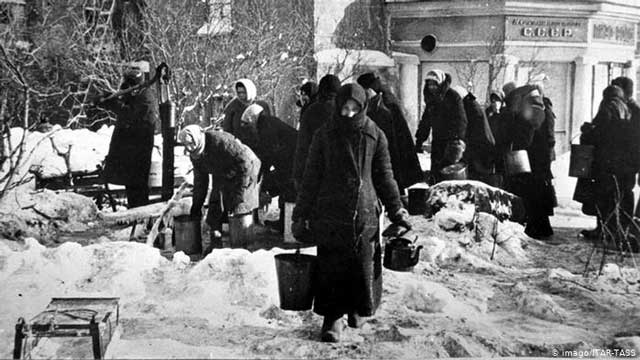 |
| Leningrad, 13 January 1942. Finding potable water, which is used to make soup for dinner. Someone has brought their sled, left, to make the daily ritual a bit easier. |
President Franklin D. Roosevelt forms the U.S. War Production Board. Its chairman is Donald M. Nelson. The WPB replaces the Supply Priorities and Allocation Board. Nelson's main job is helping or forcing civilian factories (such as the major automobile factories in Detroit) to convert to war production.
Nineteen shipyards on the west coast go to continuous, around-the-clock, seven-day-a-week production schedules. The U.S. Maritime Commission faces a manpower crisis in the shipyards, many of which are newly built in areas without experienced workers. This leads to more employment by women and Africa-Americans. Major production yards are located at Oakland and San Francisco, California, Tacoma, Washington, and Portland, Oregon. Henry J. Kaiser is a major driving force behind ship construction on the west coast, and he has several yards for his Kaiser Permanente organization at Richmond, California.
At the Metropolitan Museum of Modern Art in New York, the new exhibition is Latin-American Art. Among the artists featured are Diego Rivera, famous for his murals such as one in the lobby of Rockefeller Center, and Wifredo Lams. The United States is doing everything it can think of to tighten ties with Latin America during the early days of the war.
 |
| "A Chief Petty Officer Wren in charge of Teleprinting Trainees checks results with a Wren Trainee Teleprinter operator." St. Leonard House, Rosyth Command, 13 January 1942 (© IWM (A 7043)). |
|
1942January 1942January 1, 1942: Declaration By United NationsJanuary 2, 1941: Manila Falls to JapanJanuary 3, 1942: ABDA Command AnnouncedJanuary 4, 1942: MacArthur on His Own in the PhilippinesJanuary 5, 1942: Soviets Plan General OffensiveJanuary 6, 1942: US Army in EuropeJanuary 7, 1942: Soviet General Offensive OpensJanuary 8, 1942: Hitler Sacks HoepnerJanuary 9, 1942: Battle of DražgošeJanuary 10, 1942: Building the JeepJanuary 11, 1942: Japan Takes Kuala LumpurJanuary 12, 1941: Rommel Plans CounterattackJanuary 13, 1942: First Ejection Seat UseJanuary 14, 1942: Operation Drumbeat First SinkingJanuary 15, 1942: U-Boat Off NYCJanuary 16, 1942: Carole Lombard CrashJanuary 17, 1942: British Take Halfaya PassJanuary 18, 1942: Soviet Paratroopers in ActionJanuary 19, 1942: FDR Approves Atomic BombJanuary 20, 1942: The Wannsee ConferenceJanuary 21, 1942: Parit Sulong Bridge BattleJanuary 22, 1942: Parit Sulong MassacreJanuary 23, 1942: Japan Takes RabaulJanuary 24, 1942: Battle of Makassar StraitJanuary 25, 1942: Kholm SurroundedJanuary 26, 1942: GIs Land in EuropeJanuary 27, 1942: Battle of EndauJanuary 28, 1942: Rommel Takes BenghaziJanuary 29, 1942: First US Coast Guard Ship SunkJanuary 30, 1942: Singapore IsolatedJanuary 31, 1942: Army Group South Averts Disaster2020

















